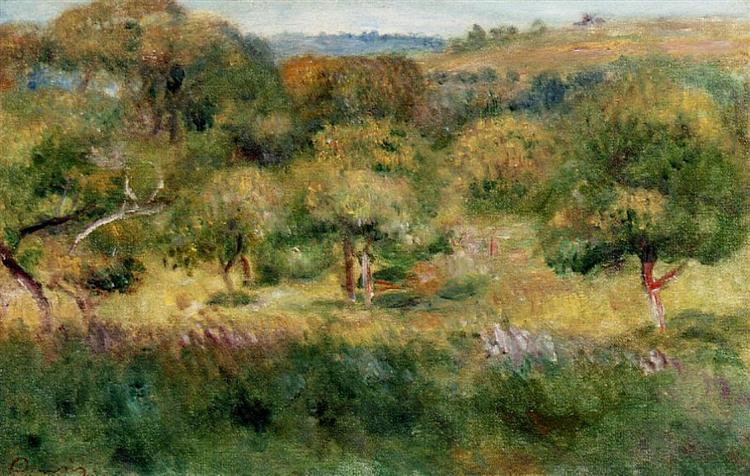Description
Pierre-Auguste Renoir's "The Edge of the Forest in Brittany" (1893) is a clear example of the artist's transition from Impressionism to a more classical style, characterized by the luminosity and vibrant color palette that distinguishes him. In this painting, Renoir captures a fleeting moment in nature, presenting a scene where light, landscape and a peculiar sense of intimacy intertwine.
The composition offers an almost reassuring image that shows the transition from the forest to a vast expanse of countryside. The trees, grouped together on the left, create a natural frame that directs the viewer's gaze towards the centre of the painting. This distance invites introspective contemplation and highlights the almost mystical connection between man and nature. The perspective is carefully considered; the path drawn in the foreground seems to move away, suggesting a route that may or may not be explored.
The use of colour in the work is remarkable, with a rich variety ranging from the emerald greens of the vegetation to the golden and terracotta tones that suggest the warmth of the sun filtering through the leaves. Renoir applies a loose brushstroke technique that allows the colours to seem to vibrate with a life of their own, a distinctive feature of his style. The reflections of light on the trees and the ground are especially captivating; Renoir not only portrays nature, but also seems to invite the viewer to feel the warmth and freshness of the Brittany air. Light, as in many of his works, plays a vital role, creating an atmosphere that is at once nostalgic and hopeful.
Although there are no clearly defined human figures in this work, the choice of subject suggests an implicit human presence. The scene echoes the escapes that Renoir himself enjoyed, as he spent time in nature, away from the distractions of urban life. This aspect reflects the desire for seclusion and tranquility that many people feel in their interactions with the natural environment.
Renoir, one of the most prominent members of the Impressionist movement, spent his early years experimenting with forms and perceptions of light, creating works that often focused on social life and the human figure. With The Edge of the Forest in Brittany, he expresses a preference for communion with nature that is revealed in the works of the late Impressionists. This painting aligns with other creations from the same period that explore landscapes and moments shared with the environment, reminding us of the importance of connection with the natural world.
In terms of historical context, this work was created at a time when Renoir had already established his renown but was continuing to evolve as an artist. It is at a phase when he was seeking a balance between the sensorial drive of Impressionism and a more structured, composition-prone approach. "The Edge of the Forest in Brittany" stands not only as a depiction of a rural landscape but also as an encapsulation of Renoir's search for beauty and harmony in his work.
In short, The Edge of the Forest in Brittany is a contemplative work that offers an opportunity to reflect on the role nature plays in artistic expression. Renoir, through his technical mastery and sensitive approach to the landscape, reminds us of the importance of observing and appreciating the simple moments that life has to offer. The work lives on as a testament to his legacy within Impressionism and his ongoing dialogue with nature, in which light, color and form combine to create a unique and evocative visual experience.
KUADROS ©, a famous painting on your wall.
Hand-made oil painting reproductions, with the quality of professional artists and the distinctive seal of KUADROS ©.
Painting reproduction service with satisfaction guarantee. If you are not completely satisfied with the replica of your painting, we will refund 100% of your money.

